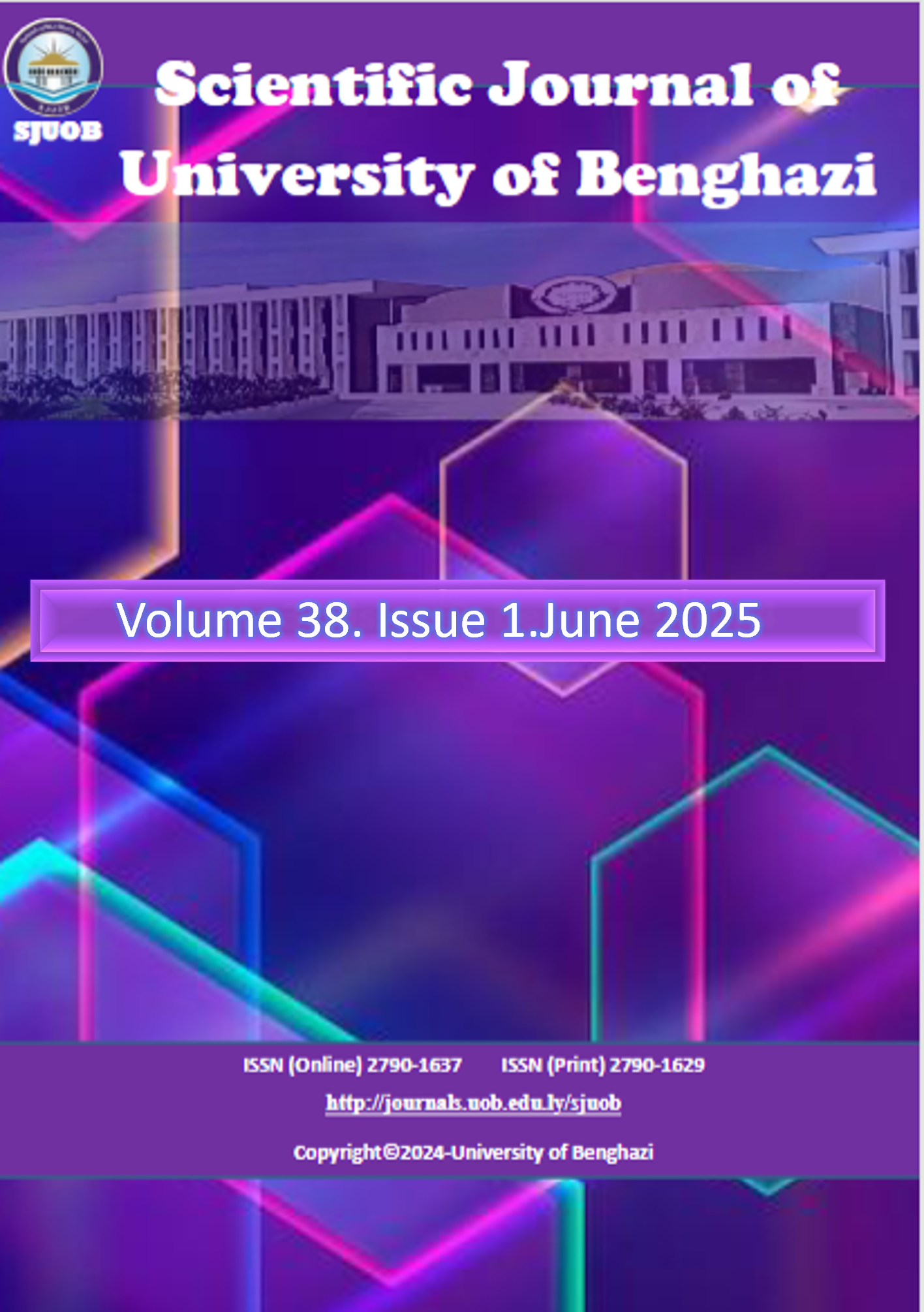Impact of CT Stroke Window Settings on Acute Stroke Detection.
DOI:
https://doi.org/10.37376/sjuob.v38i1.7328Keywords:
Default brain window, Early ischemic changes, Non-contrast CT, Sensitivity, Stroke window, Window settings, Window widthAbstract
Non-contrast CT is the most important imaging modality in the evaluation of suspected acute stroke by excluding intracranial haemorrhage and directly visualizing early ischemic changes. These changes are challenging to detect on non-contrast CT due to the small reduction in the attenuation value of ischemic tissue from normal. The study’s objective was to assess the use of stroke window settings for improving the detection of acute stroke. This retrospective study included forty-nine patients in whom non-contrast CT were performed for suspected acute stroke within 24 hours from symptom onset. Images were reviewed in two reading sessions with different window settings used: default brain window (80/40 [window width/window level]) and stroke window (40/40 [window width/window level]). Both windows were evaluated for their ability to detect early ischemic changes with the final diagnosis as the reference standard. Twenty-nine patients had a final diagnosis of acute stroke. The sensitivity and specificity of non-contrast CT for acute stroke detection were 79.3% and 100% respectively at the default brain window. Both windows were comparable for detecting acute stroke (P=0.2). The CT sensitivity increased to 86.2% after adding the stroke window review to the default brain window. The resultant improvement in CT diagnostic performance by stroke window review was not statistically significant (P=0.5). Conclusion, the superior sensitivity of applying stroke window settings after the default window review is small with modern generation CT scanner. These findings should increase the confidence in routine radiology reporting that uses the standard brain window in the assessment of acute stroke.Downloads
References
World health rankings live longer live better. World Life Expectancy Com [Internet]. 2020 [cited 2024 Oct 16]. Available from: https://www.worldlifeexpectancy.com/libya-stroke
Wall SD, Brant-Zawadzki M, Jeffrey RB, Barnes B. High frequency CT findings within 24 hours after cerebral infarction. AJR. Am J Roentgenol. 1982 Feb; 138(2):307–311. Available from: doi: 10.2214/ajr.138.2.307
Abdalkader M, Siegler JE, Lee JS, Yaghi S, Qiu Z, Huo X, et al. Neuroimaging of acute ischemic stroke: Multimodal imaging approach for acute endovascular therapy. J Stroke. 2023 Jan; 25(1):55-71. Available from: doi: 10.5853/jos.2022.03286
Tedyanto EH, Tini K, Pramana NAK. Magnetic resonance imaging in acute ischemic Stroke. Cureus. 2022 Jul 25; 14(7):e27224. Available from: doi: 10.7759/cureus.27224
DenOtter TD, Schubert J. Hounsfield unit. StatPearls: StatPearls Publishing; 2023.
Xue Z, Antani S, Long LR, Demner-Fushman D, Thoma GR. Window classification of brain CT images in biomedical articles. AMIA Annu Symp Proc. 2012; 2012:1023–1029
Bibb R, Eggbeer D, Paterson A. 2 - Medical imaging. In Bibb R, Eggbeer D, Paterson A, editors. Medical modelling. 2nd Ed. Woodhead Publishing; 2015. p. 7-34. https://doi.org/10.1016/B978-1-78242-300-3.00002-0.
Mandell JC, Khurana B, Folio LR, Hyun H, Smith SE, Dunne RM, et al. Clinical applications of a CT window blending algorithm: RADIO (Relative Attenuation-Dependent Image Overlay). J Digit Imaging. 2017 Jun; 30(3):358–368. Available from: doi: 10.1007/s10278-017-9941-1
Fundamentals of computed tomography studies: Windowing. Stepwards [Internet]. 2019 [cited 2024 Sep 15]. Available from: https://www.stepwards.com/?page_id=21646
Karki M, Cho J, Lee E, Hahm MH, Yoon SY, Kim M, et al. CT window trainable neural network for improving intracranial hemorrhage detection by combining multiple settings. Artif Intell Med. 2020 Jun; 106:101850. Available from: doi: 10.1016/j.artmed.2020.101850
Viriyavisuthisakul S, Kaothanthong N, Sanguansat P, Haruechaiyasak C, Nguyen ML, Sarampakhul S, et al. Evaluation of window parameters of Noncontrast cranial CT brain images for Hyperacute and acute ischemic stroke classification with deep learning. Proceedings of the 11th Annual International Conference on Industrial Engineering and Operations Management. IEOM Society; 2021. p. 170-188.
Cho J, Park KS, Karki M, Lee E, Ko S, Kim JK, et al. Improving sensitivity on identification and delineation of intracranial hemorrhage lesion using cascaded deep learning models. J Digit Imaging. 2019 Jun; 32(3):450-461. Available from: doi: 10.1007/s10278-018-00172-1.
Turner PJ, Holdsworth G. Commentary. CT stroke window settings: an unfortunate misleading misnomer? Br J Radiol. 2011 Dec; 84(1008):1061-6. Available from: doi: 10.1259/bjr/99730184.
Lev MH, Farkas J, Gemmete JJ, Hossain ST, Hunter GJ, Koroshetz WJ, et al. Acute stroke: Improved nonenhanced CT detection--benefits of soft-copy interpretation by using variable window width and center level settings. Radiology. 1999 Oct; 213(1):150-5. Available from: doi: 10.1148/radiology.213.1.r99oc10150.
Mainali S, Wahba M, Elijovich L. Detection of early ischemic changes in noncontrast CT head improved with “stroke windows”. ISRN Neurosci. 2014 Mar 9; 2014:654980. Available from: doi: 10.1155/2014/654980.
Rowley H, Vagal A. (2020). Chapter 3 Stroke and stroke mimics: Diagnosis and treatment. In: Hodler J, Kubik-Huch RA, von Schulthess GK, editors. Diseases of the brain, head and neck, spine 2020–2023: Diagnostic imaging [Internet]. Cham (CH): Springer; 2020. Chapter 3. Available from: doi: 10.1007/978-3-030-38490-6_3
van Poppel LM, Majoie CBLM, Marquering HA, Emmer BJ. Associations between early ischemic signs on non-contrast CT and time since acute ischemic stroke onset: A scoping review. Eur J Radiol. 2022 Oct; 155:110455. Available from: doi: 10.1016/j.ejrad.2022.110455.
Oguro S, Mugikura S, Ota H, Bito S, Asami Y, Sotome W, et al. Usefulness of maximum intensity projection images of non-enhanced CT for detection of hyperdense middle cerebral artery sign in acute thromboembolic ischemic stroke. JJR. Japanese journal of radiology. 2022; 40(10):1046–1052. Available from: doi: 10.1007/s11604-022-01289-8
Nian K, Harding IC, Herman IM, Ebong EE. Blood-brain barrier damage in ischemic stroke and its regulation by endothelial mechanotransduction. Front Physiol. 2020 Dec 22; 11:605398. Available from: doi: 10.3389/fphys.2020.605398.
Vu D, Lev MH. Noncontrast CT in acute stroke. Semin Ultrasound CT MR. 2005 Dec; 26(6):380-6. Available from: doi: 10.1053/j.sult.2005.07.008.
Latchaw RE, Alberts MJ, Lev MH, Connors JJ, Harbaugh RE, Higashida RT, et al. Recommendations for imaging of acute ischemic stroke: A scientific statement from the American Heart Association. Stroke. 2009 Sep 24; 40(11):3646–3678. Available from: https://doi.org/10.1161/STROKEAHA.108.192616
Morgan CD, Stephens M, Zuckerman SL, Waitara MS, Morone PJ, Dewan MC, et al. Physiologic imaging in acute stroke: Patient selection. Interv Neuroradiol. 2015 Aug; 21(4):499-510. Available from: doi: 10.1177/1591019915587227.
Lin K, Do KG, Ong P, Shapiro M, Babb JS, Siller KA, et al. Perfusion CT improves diagnostic accuracy for hyperacute ischemic stroke in the 3-hour window: Study of 100 patients with diffusion MRI confirmation. Cerebrovasc Dis. 2009; 28(1):72-9. Available from: doi: 10.1159/000219300.
Shen J, Li X, Li Y, Wu B. Comparative accuracy of CT perfusion in diagnosing acute ischemic stroke: A systematic review of 27 trials. PLoS One. 2017 May 17; 12(5):e0176622. Available from: doi: 10.1371/journal.pone.0176622.
Abdulkareem NK, Hajee SI, Hassan FF, Ibrahim IK, Al-Khalidi REH, Abdulqader NA. Investigating the slice thickness effect on noise and diagnostic content of single-source multi-slice computerized axial tomography. J Med Life. 2023 Jun; 16(6):862-867. Available from: doi: 10.25122/jml-2022-0188.
Hill MD, Demchuk AM, Goyal M, Jovin TG, Foster LD, Tomsick TA, et al. Alberta Stroke Program early computed tomography score to select patients for endovascular treatment: Interventional Management of Stroke (IMS)-III Trial. Stroke. 2014 Feb; 45(2):444-449. Available from: doi: 10.1161/STROKEAHA.113.003580.
Bier G, Bongers MN, Ditt H, Bender B, Ernemann U, Horger M. Accuracy of non-enhanced CT in detecting early ischemic edema using frequency selective non-linear blending. PLoS One. 2016 Jan 25; 11(1):e0147378. Available from: doi: 10.1371/journal.pone.0147378.
Fontanella A, Li W, Mair G, et al. Development of a deep learning method to identify acute ischaemic stroke lesions on brain CT. Stroke Vasc Neurol. Published online December 25, 2024. doi:10.1136/svn-2024-003372.
Downloads
Published
How to Cite
License
Copyright (c) 2025 Scientific Journal of University of Benghazi

This work is licensed under a Creative Commons Attribution-NonCommercial-NoDerivatives 4.0 International License.



















